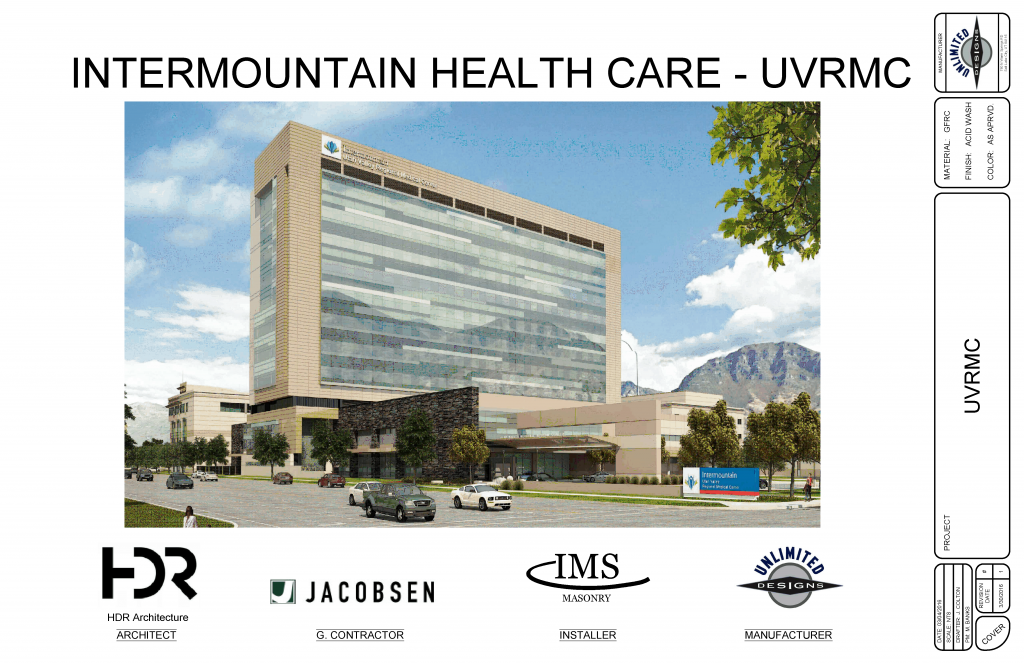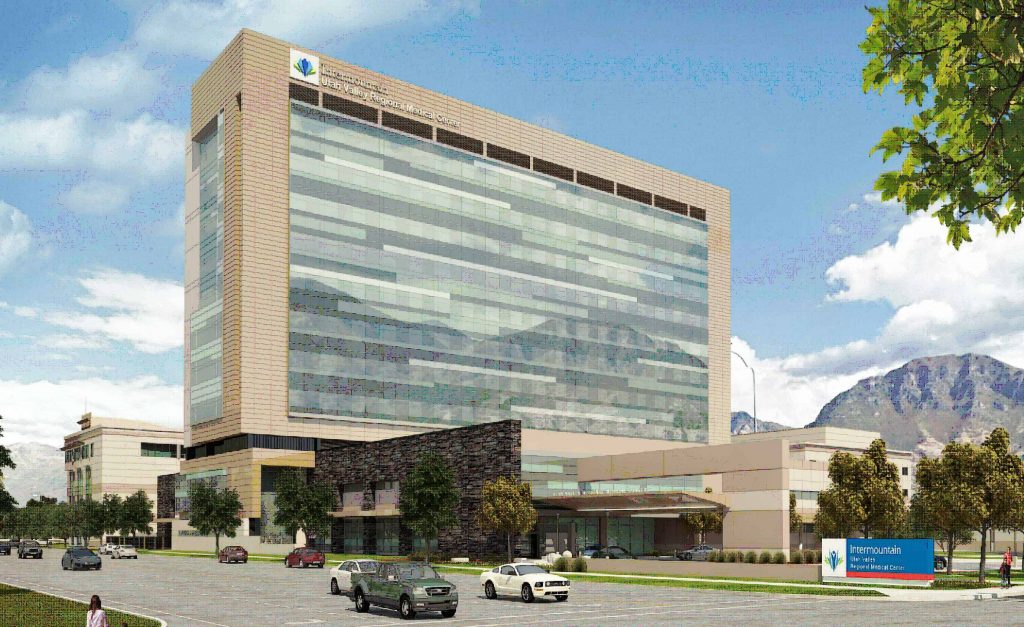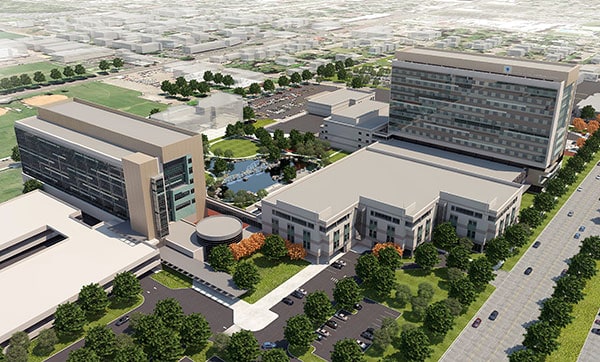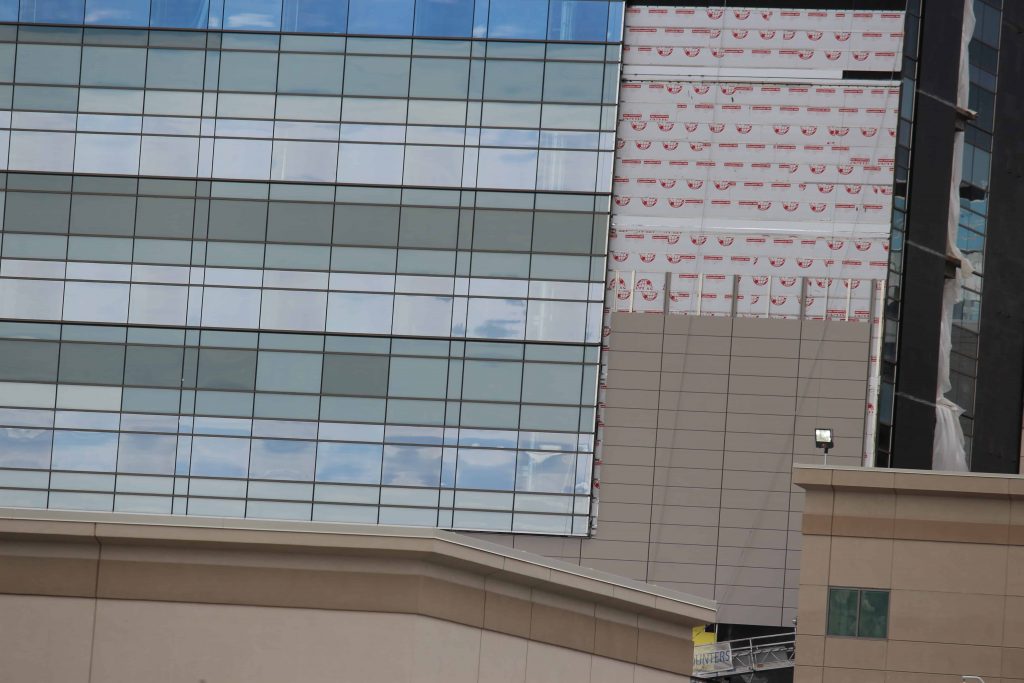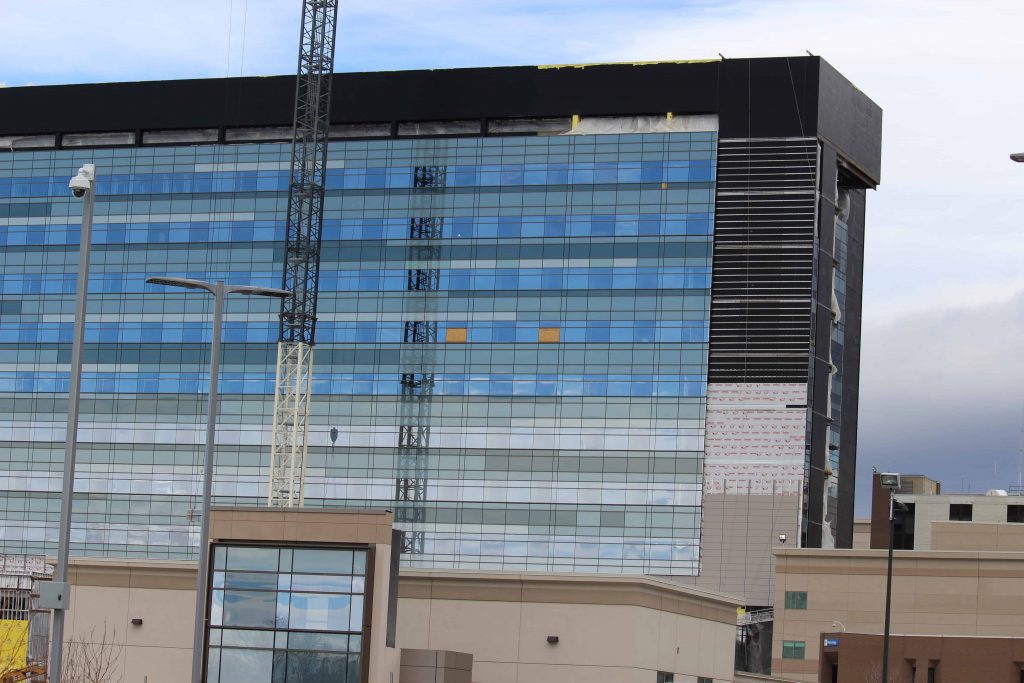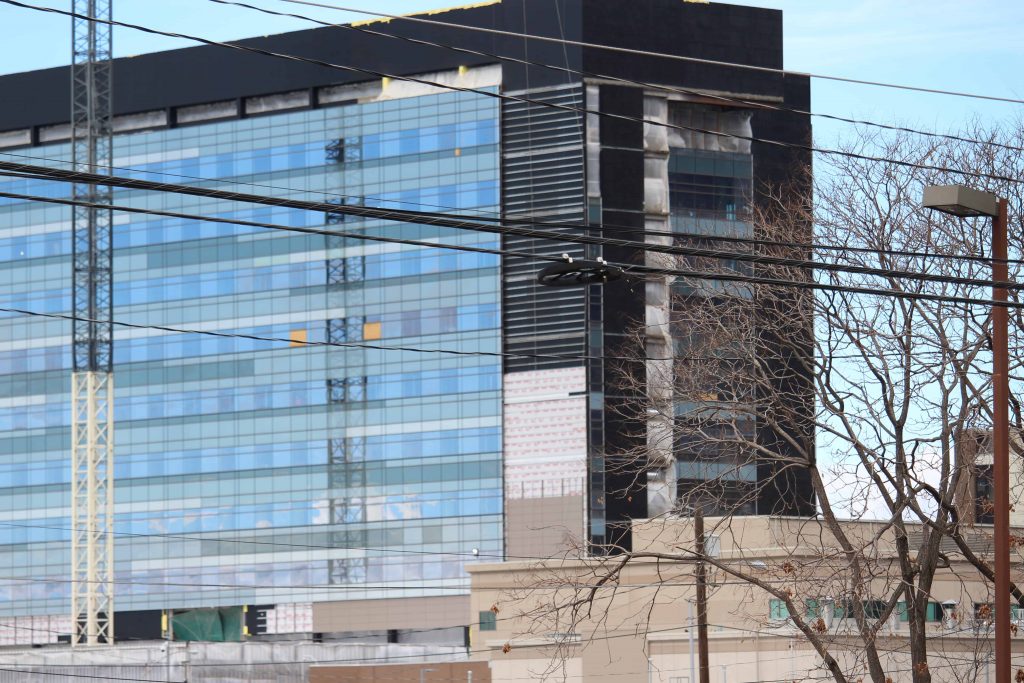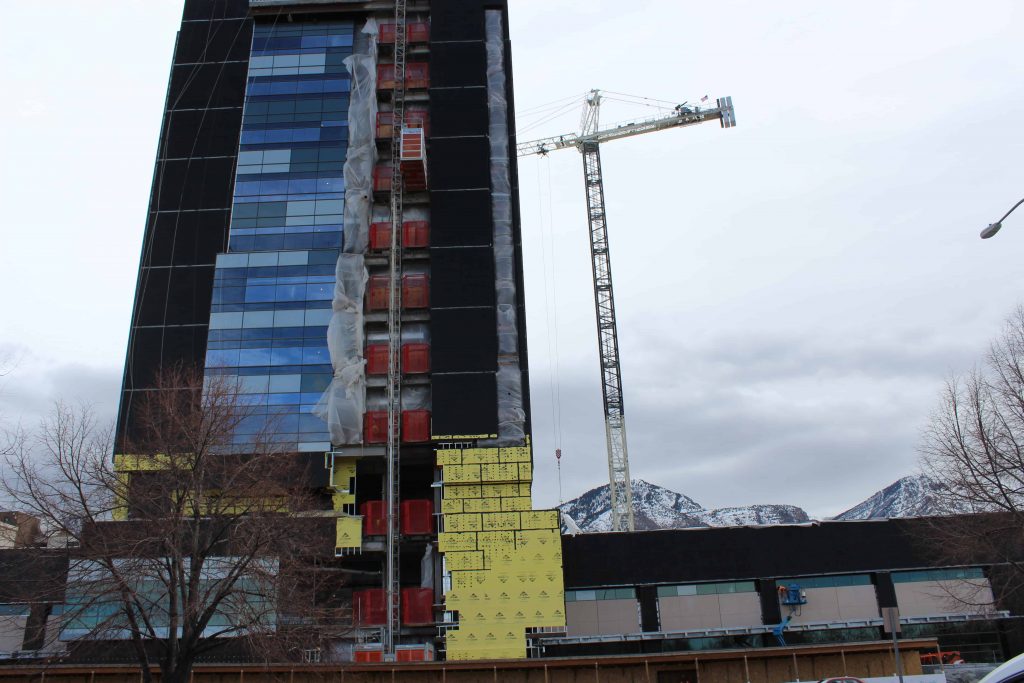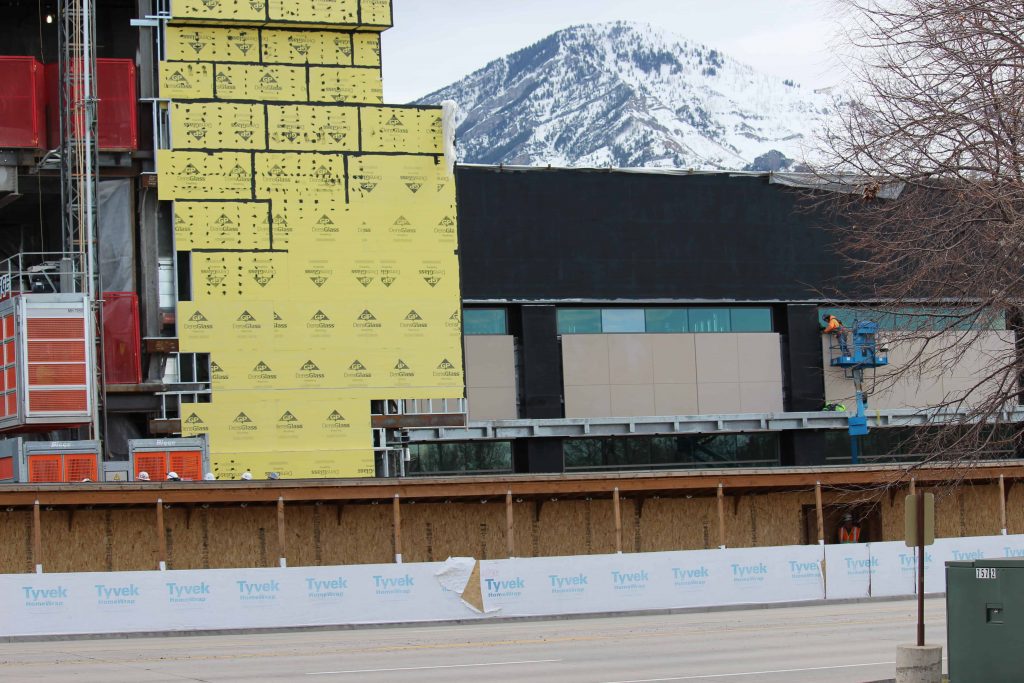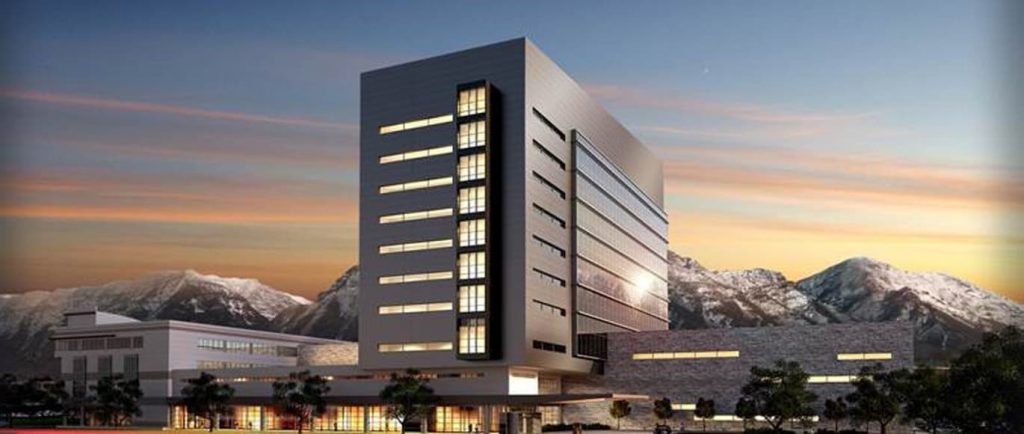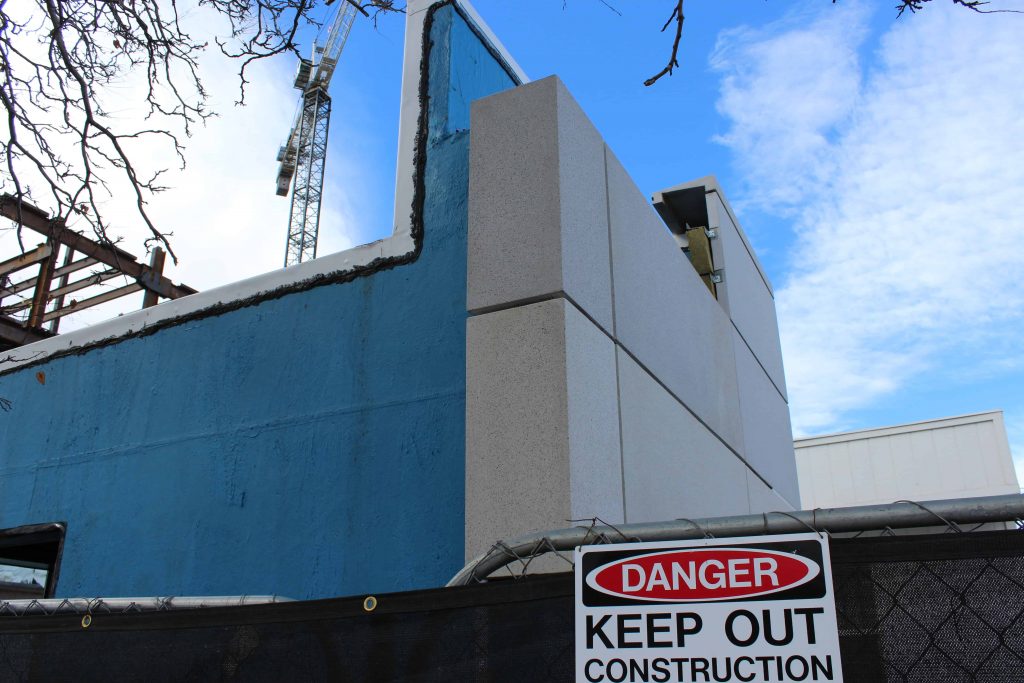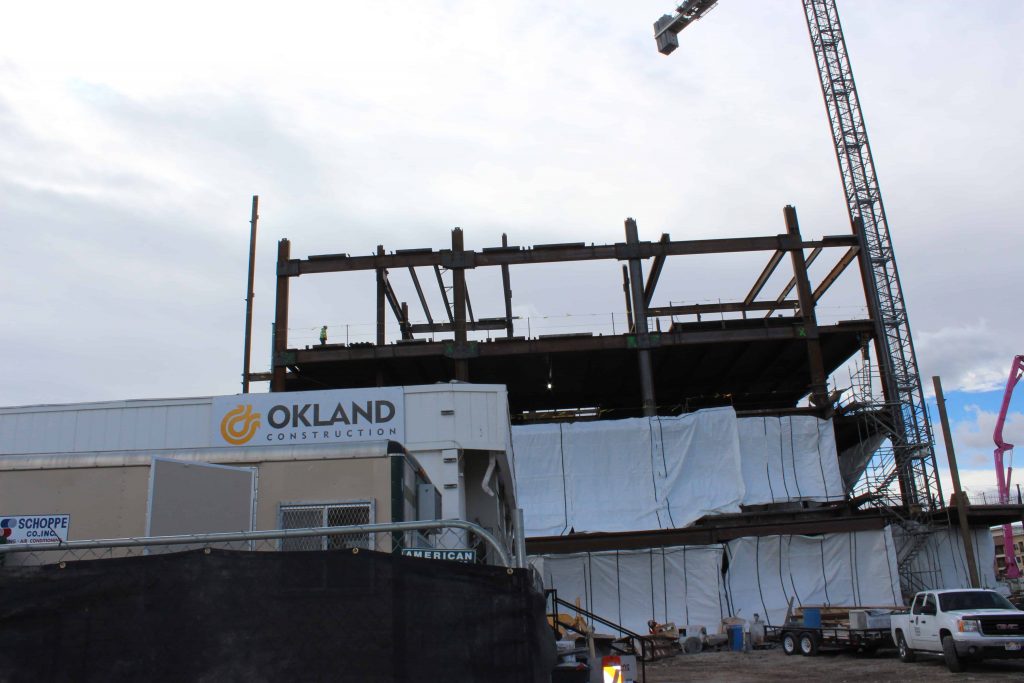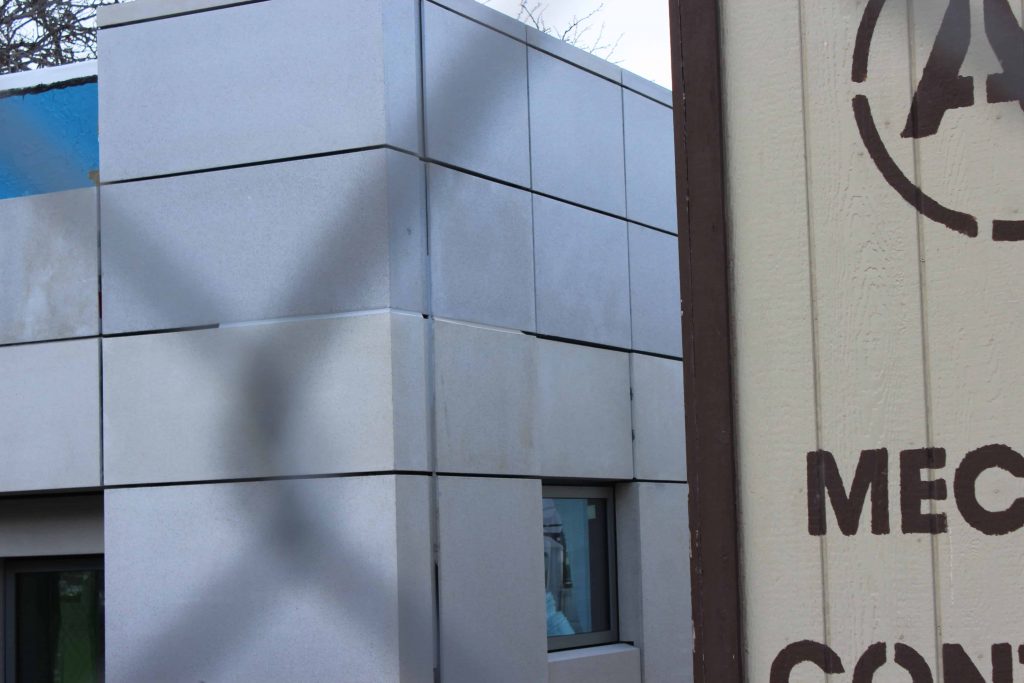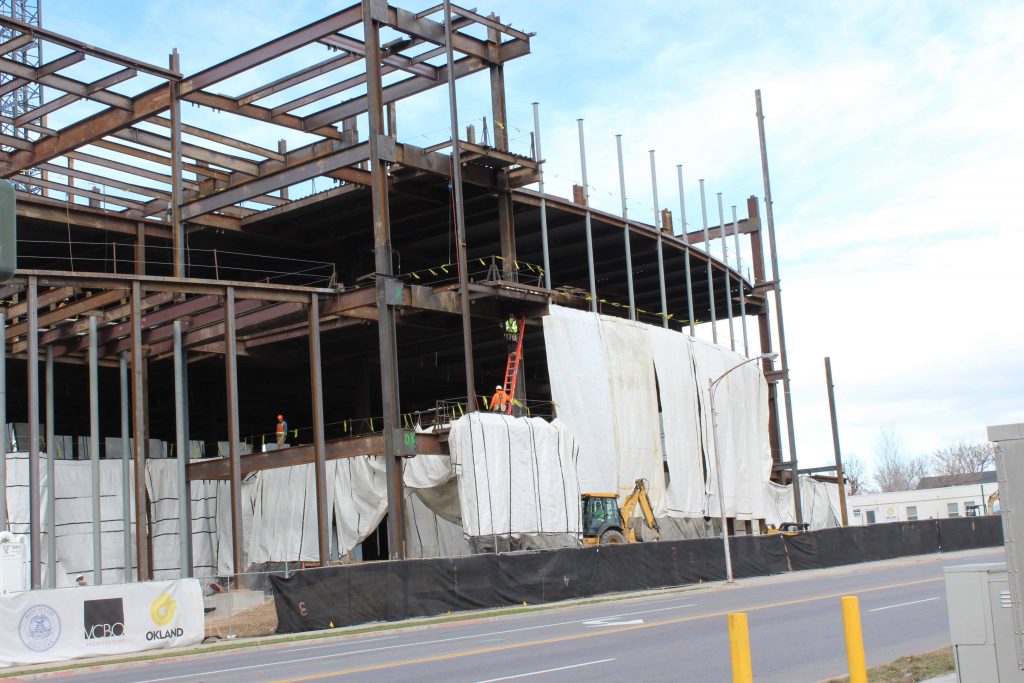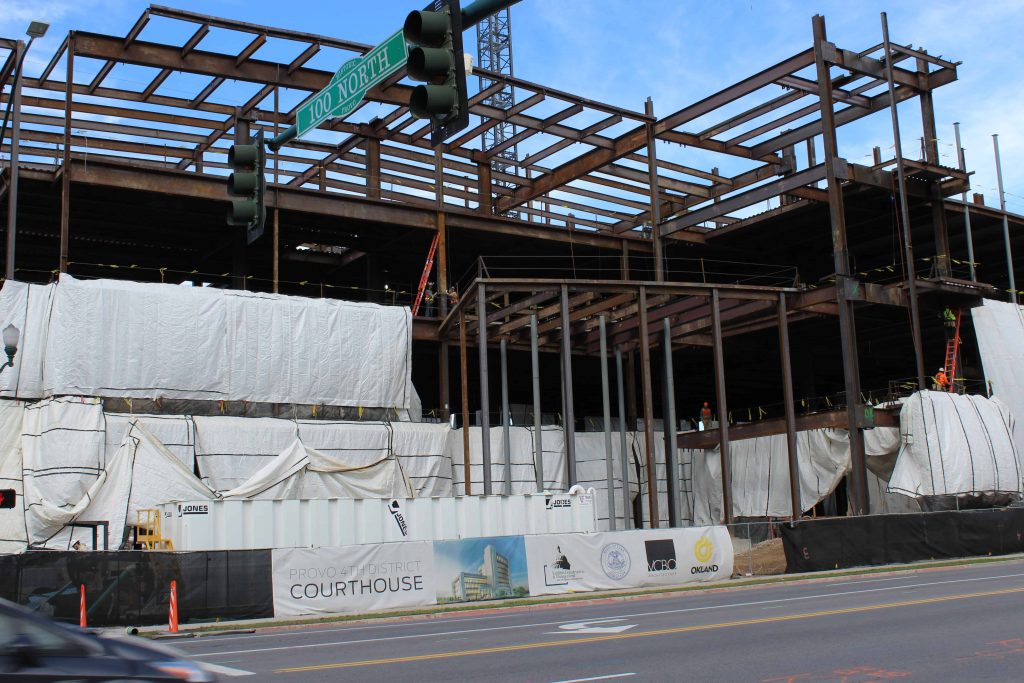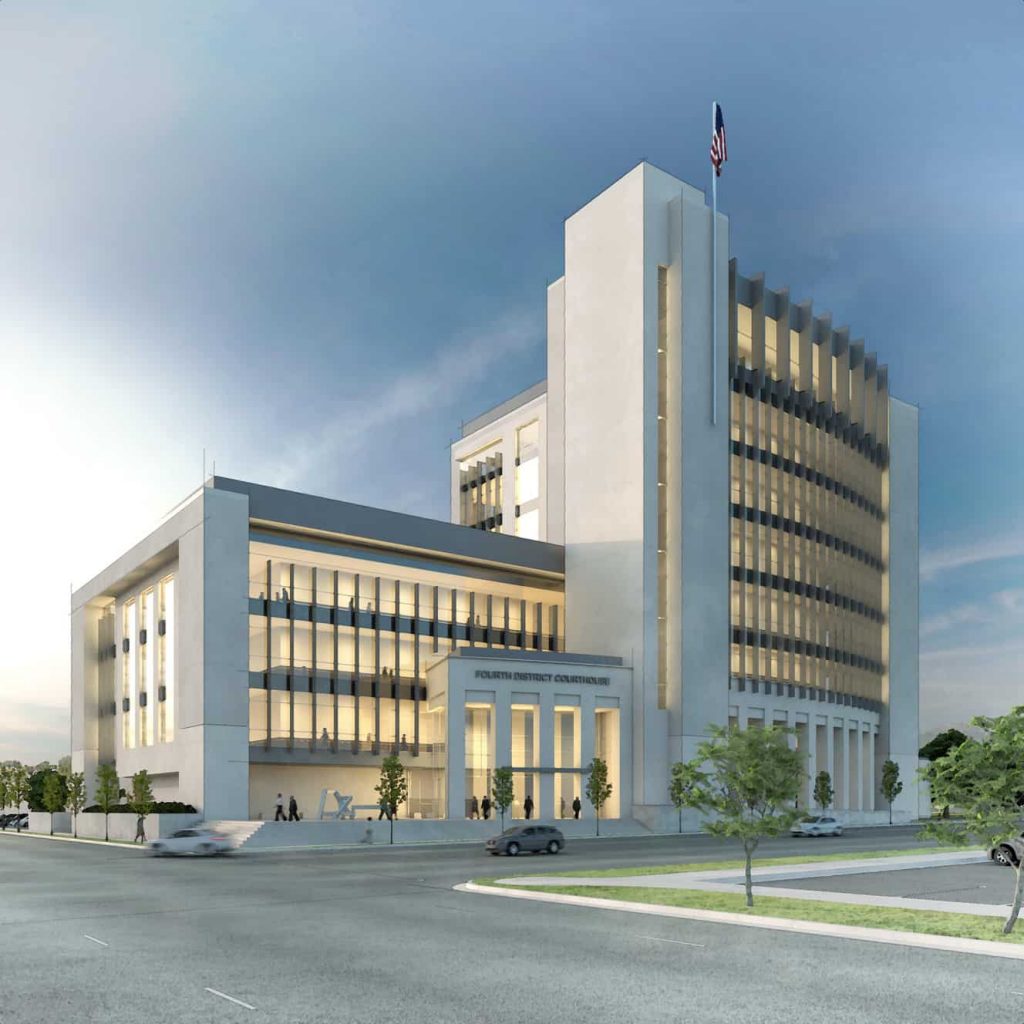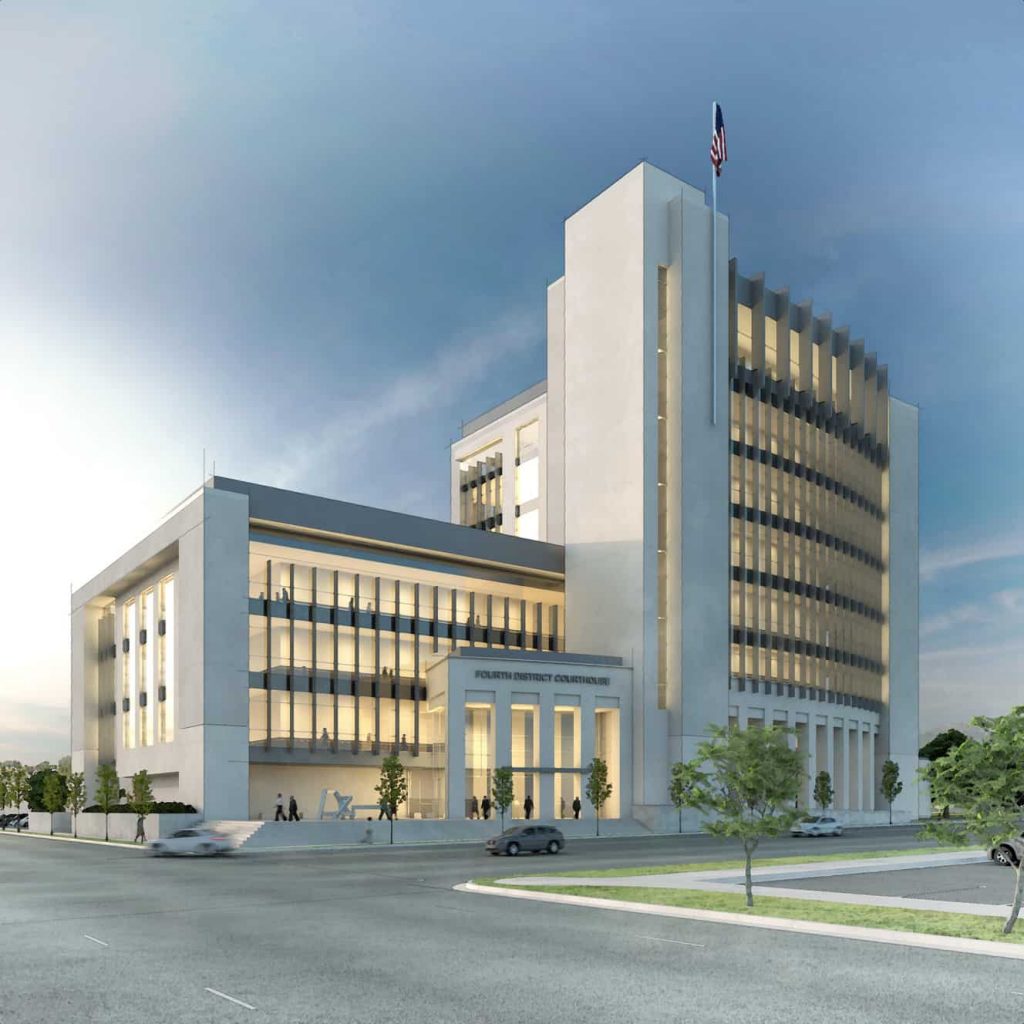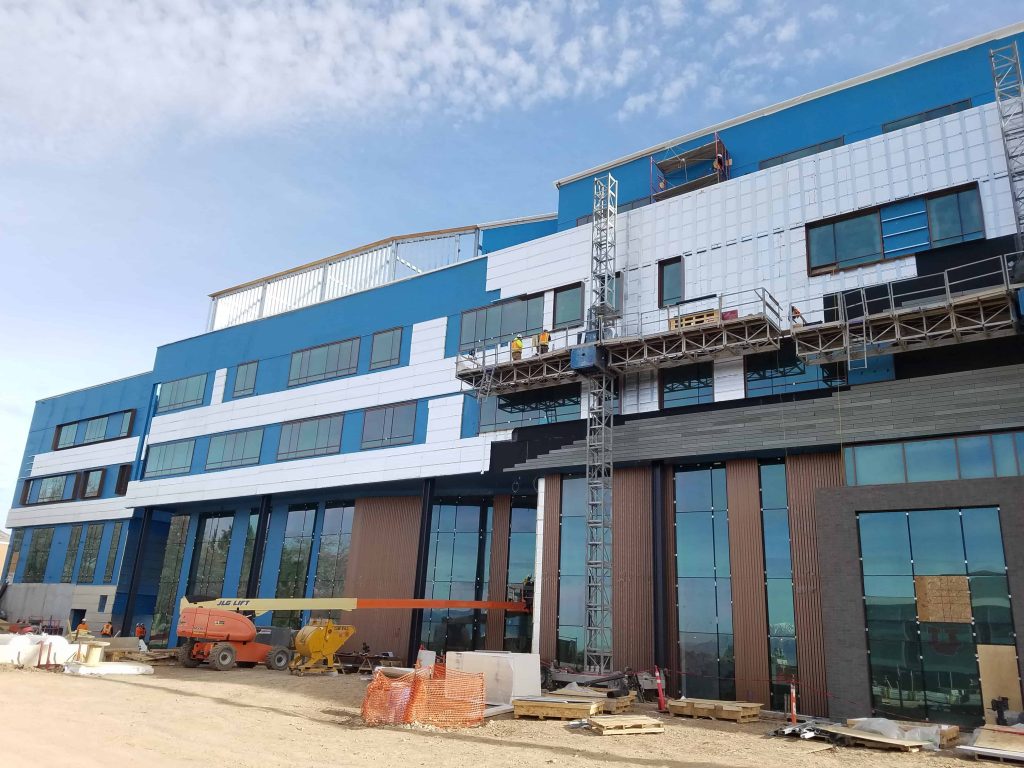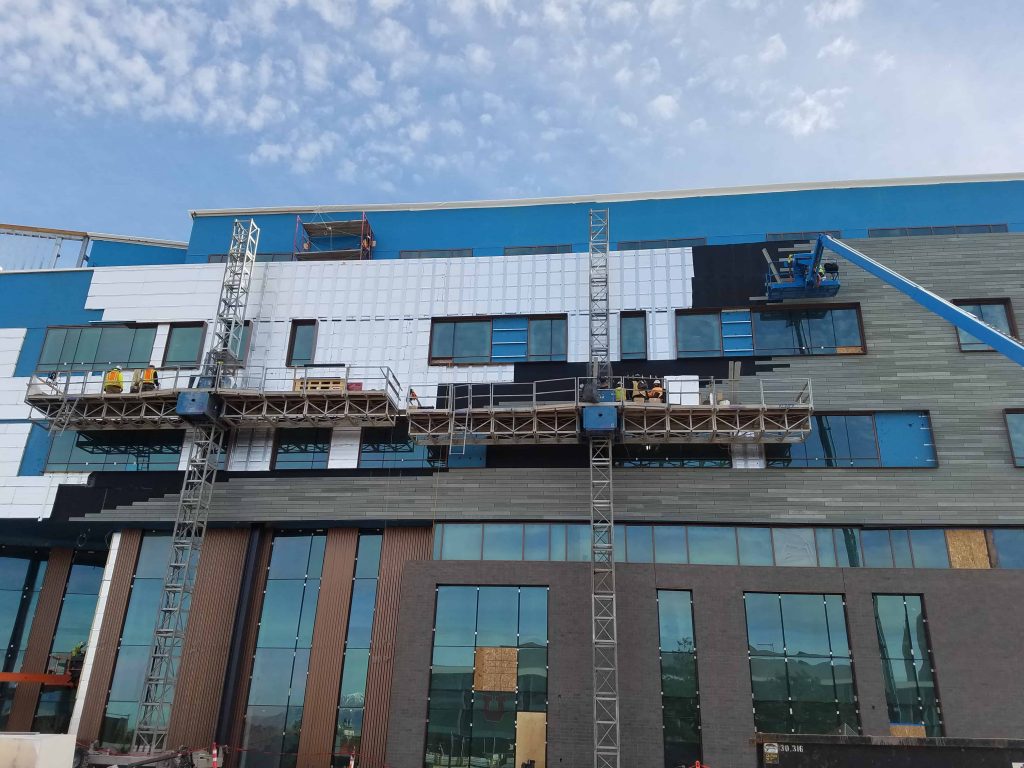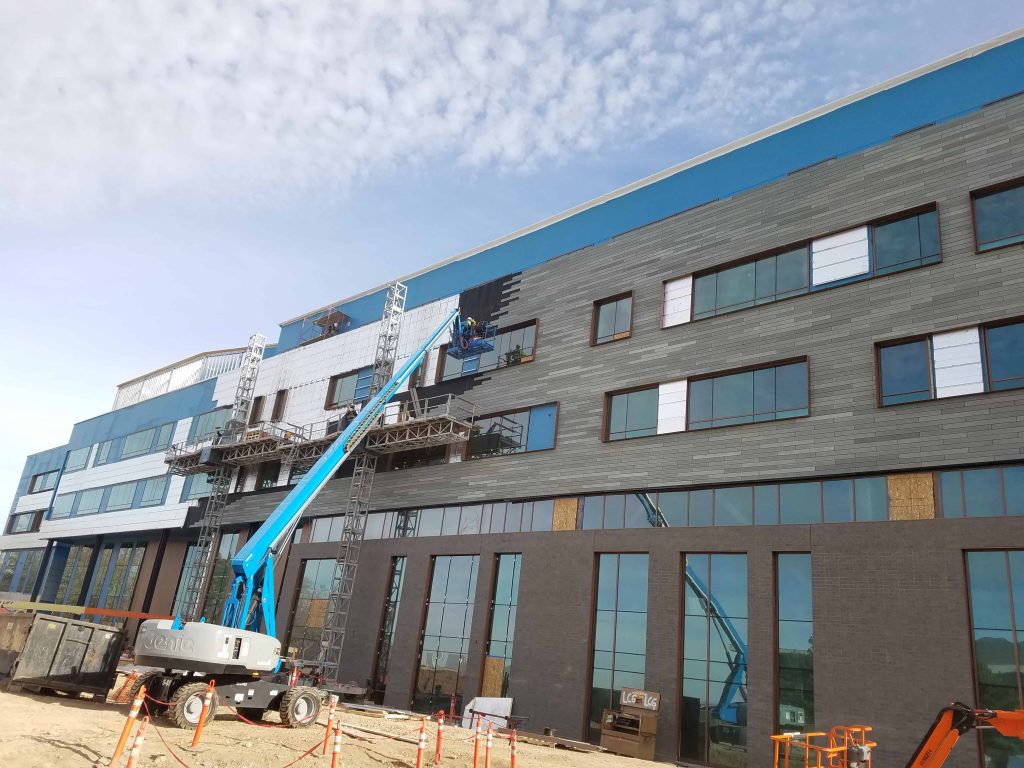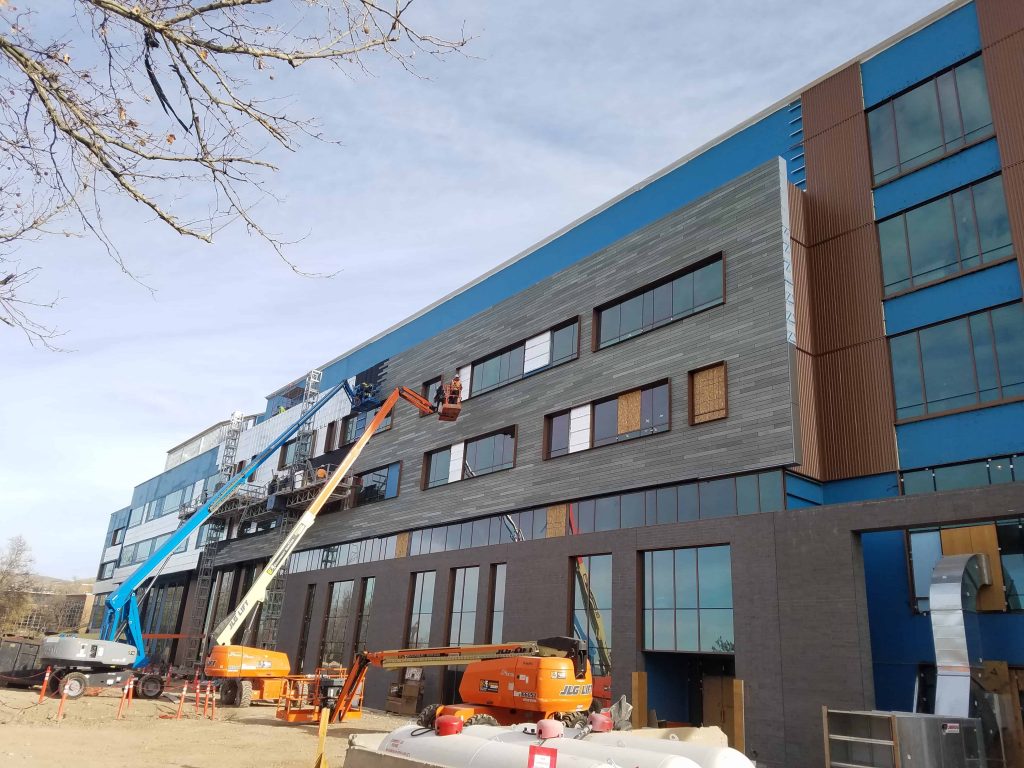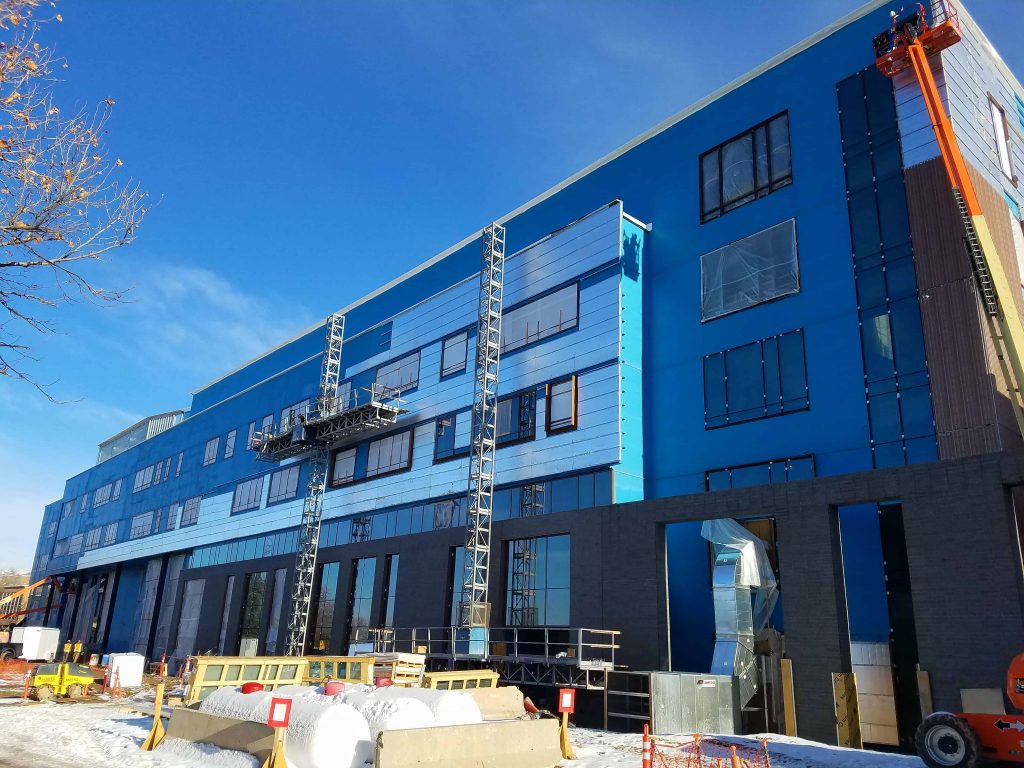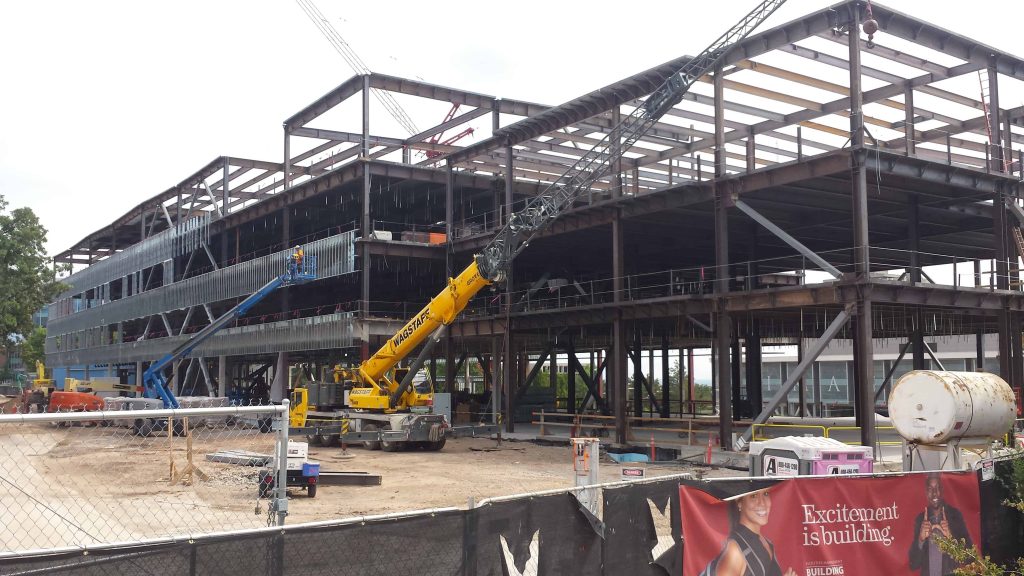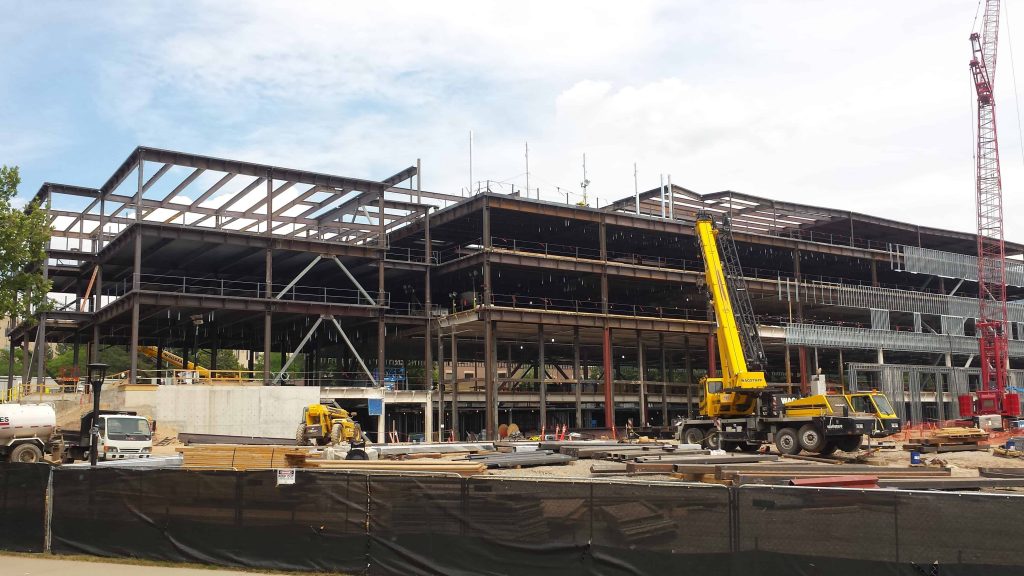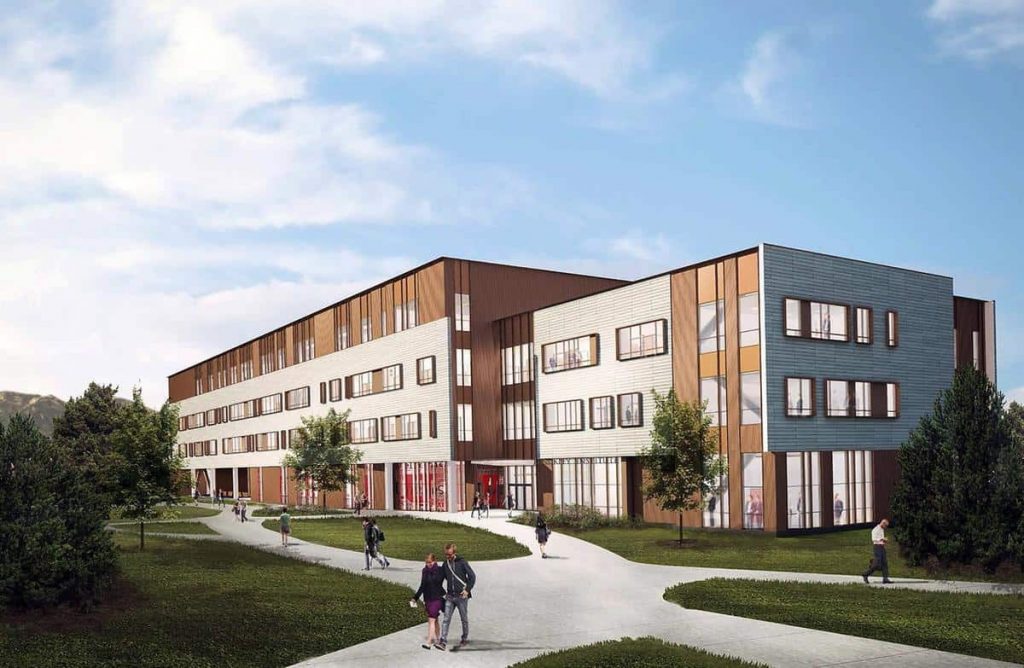Glass FIBer Reinforced Concrete (GFRC)
Download PDFs
Product Data
Exterior Cornices, columns, decorative exterior wall panels and limitless specialized decorative shape applications.
Design
Shop drawings are submitted for verification of profiles, dimensions, and surrounding construction of GFRC units. Some site cutting and/or grinding of parts may be required to suit job conditions. Field shimming may be required. Connection and attachment details are indicated on the shop drawings. It is the responsibility of the installer to follow the shop drawings and coordinate field inspections as required. Installer should verify job conditions and make installation adjustments accordingly. Installer shall get approval from GFRC engineers for deviations from the connection/attachment details indicated in the shop drawings.
Testing
| Shell Thickness (Nominal) | 3/4” |
| Weight | 8 to 8.5 lbs./sq. ft. |
| Flexural Strength | 2500 PSI |
| Tensile Strength | 975 to 1350 PSI |
| Compressive Strength | 7200 to 8100 PSI |
| Density | 110 lbs. /cu. Ft. |
| Flammability (ASTM E84) | Class I |
Fabrications
Mix – GFRC is batched and blended in accordance with industry standards using the specified mix design.
Application – GFRC mixture is sprayed and/or hand laid into molds designed to match the shape and dimensions shown on the approved shop drawings. The nominal shell thickness is 3/4”.
Finish – GFRC can be produced in a variety of finishes , some of the most common would be a acid or sandblasted finish with an integral color or with colored aggregates that produce a multi colored finish. You can also reproduce stone finishes such as limestone, Granite and sandstone. GFRC can also be finished to simulate a terra cotta finish or cast smooth to receive a wide variety of paints and coatings.
Delivery
GFRC units are created or palletized at the plant. Created units are delivered to the jobsite via truck.
Storage
Store crated GFRC products on a level surface protected from weathering and damage. Do not unpack crates until immediately prior to installation.
Handling
Use special care to prevent damage to material surface; do not allow acidic materials to come in contact with surface, as degradation and discoloration can occur.
PART 1 – GENERAL
1.1 RELATED DOCUMENTS
A. Drawings and general provisions of the Contract, including General and Supplementary Conditions and Division 01 Specification Sections, apply to this Section.
1.2 SUMMARY
A. Section includes glass-fiber-reinforced concrete (GFRC) panels consisting of GFRC, panel frames, anchors, and connection hardware.
1. GFRC panels include [wall units] [window wall units] [mullions] [column covers] [fascia units] [cornices] [soffits] <Insert applications>.
B. Related Requirements:
1. Section 033000 “Cast-in-Place Concrete” for embedding weld plates and angles in concrete for attaching connection devices.
2. Section 051200 “Structural Steel Framing” for attaching connection devices to steel framing.
3. Section 079200 “Joint Sealants” for elastomeric joint sealants and sealant backings.
1.3 DEFINITIONS
A. Design Reference Sample: Sample of GFRC color, finish, and texture that has been preapproved by Architect before execution of the Contract.
1. Design Reference Sample: <Insert description and identify manufacturer and code number of sample>.
1.4 PREINSTALLATION MEETINGS
A. Preinstallation Conference: Conduct conference at [Project site] <Insert location>.
1.5 ACTION SUBMITTALS
A. Product Data: For each type of product. Include GFRC design mixes.
B. Shop Drawings: Show fabrication and installation details for GFRC panels including the following:
1. Panel elevations, sections, and dimensions.
2. Thickness of facing mix, GFRC backing, and bonding pads for typical panels.
3. Finishes.
4. Joint and connection details.
5. Erection details.
6. Panel frame details for typical panels including sizes, spacings, thicknesses, and yield strengths of various members.
7. Locations and details of connection hardware attached to structure.
8. Sizes, locations, and details of flex, gravity, and seismic anchors for typical panels.
9. Other items sprayed into panels.
10. Erection sequence for special conditions.
11. Relationship to adjacent materials.
12. Description of loose, cast-in, and field hardware.
C. Samples for Verification: For each type of finish indicated on exposed GFRC surfaces, representative of finish, color, and texture variations expected, approximately 12 by 12 inches (305 by 305 mm) by actual thickness.
D. Delegated-Design Submittal: For GFRC panels, including analysis data signed and sealed by the qualified professional engineer responsible for their preparation.
1.6 INFORMATIONAL SUBMITTALS
A. Qualification Data: For manufacturer.
B. Welding certificates.
C. Steel Sheet Certificates: For steel sheet used in cold-formed steel panel framing, mill certificates signed by manufacturers of steel sheet, or test reports from a qualified testing agency, indicating that steel sheet used in cold-formed metal panel framing complies with requirements including uncoated steel thickness, yield strength, tensile strength, total elongation, chemical requirements, and galvanized-coating thickness.
D. Mill Certificates: For structural-steel shapes and hollow structural sections used in panel framing.
E. Source Quality-Control Program: For GFRC manufacturer.
F. Source Quality-Control Test Reports: For GFRC, inserts, and anchors.
1.7 QUALITY ASSURANCE
A. Manufacturer Qualifications: Designated a PCI-certified plant for Group G – Glass Fiber Reinforced Concrete[ or designated an APA-certified plant for GFRC production].
B. Installer Qualifications: Manufacturer of GFRC panels.
C. Welding Qualifications: Qualify procedures and personnel according to AWS D1.1/D1.1M, “Structural Welding Code – Steel,” and AWS D1.3/D1.3M, “Structural Welding Code – Sheet Steel.”
D. Mockups: Build mockups to demonstrate aesthetic effects and to set quality standards for fabrication and installation.
1. Build mockup of typical wall area as shown on Drawings.
a. Include typical components, attachments to building structure, and methods of installation.
b. Include window opening with GFRC returns.
c. Include sealant-filled joint complying with requirements in Section 079200 “Joint Sealants.”
2. Subject to compliance with requirements, approved mockups may become part of the completed Work if undisturbed at time of Substantial Completion.
1.8 DELIVERY, STORAGE, AND HANDLING
A. Handle and transport GFRC panels supported on nonstaining material and with nonstaining resilient spacers between panels.
B. Store GFRC panels off of ground on firm, level, and smooth surfaces supported on nonstaining material and with nonstaining resilient spacers between panels. Place stored panels so identification marks are clearly visible.
PART 2 – PRODUCTS
2.1 MANUFACTURERS
A. Manufacturers: Subject to compliance with requirements, [provide products by the following] [provide products by one of the following] [available manufacturers offering products that may be incorporated into the Work include, but are not limited to, the following]:
1. Unlimited Designs Inc. 780 North Warm Springs Rd, Salt Lake City, Utah 84116
2. Forterra. 511 E John Carpenter Freeway, Irving, Texas 75062
3. Gate Precast. Hillsboro Texas
4. Brailsford Cast Stone. Springville Utah
B. Source Limitations: Obtain GFRC panels from single source from single manufacturer.
2.2 PERFORMANCE REQUIREMENTS
A. Delegated Design: Engage a qualified professional engineer, as defined in Section 014000 “Quality Requirements,” to design GFRC panels, including panel frames, anchors, and connections.
B. Structural Performance: GFRC panels, including panel frames, anchors, and connections, shall withstand the following design loads as well as the effects of thermal- and moisture-induced dimensional changes within limits and under conditions indicated:
1. Loads: As indicated.
2. Dead Loads: <Insert loads>.
3. Live Loads: <Insert loads>.
4. Wind Loads: <Insert applicable wind loads or wind-load criteria, positive and negative for various parts of building as required by applicable building code or ASCE/SEI 7, including basic wind speed, importance factor, exposure category, and pressure coefficient>.
5. Seismic Loads: <Insert applicable seismic design data including seismic performance category, importance factor, use group, seismic design category, seismic zone, site classification, site coefficient, and drift criteria>.
6. Project-Specific Loads: <Insert applicable loads>.
7. Deflection Limits: Design panel frames to withstand design loads without lateral deflections greater than 1/240 of wall span.
8. Thermal Movements: Provide for thermal movements resulting from annual ambient temperature changes of [80 deg F (26 deg C)] [120 deg F (67 deg C)] <Insert temperature>.
9. Design panel frames and connections to accommodate deflections and other building movements.
10. Design panel frames to transfer window loads to building structure.
C. PCI Manuals: Comply with requirements and recommendations in the following PCI manuals unless more stringent requirements are indicated:
1. PCI MNL 128, “Recommended Practice for Glass Fiber Reinforced Concrete Panels.”
2. PCI MNL 130, “Manual for Quality Control for Plants and Production of Glass Fiber Reinforced Concrete Products.”
D. AISI Specifications: Comply with AISI’s “North American Specification for the Design of Cold-Formed Steel Structural Members.”
E. AISC Specifications: Comply with AISC 360, “Specification for Structural Steel Buildings.”
2.3 MOLD MATERIALS
A. Molds: Rigid, dimensionally stable, non-absorptive material, warp and buckle free, that provides continuous GFRC surfaces within tolerances; nonreactive with GFRC and capable of producing required finish surfaces.
1. Mold-Release Agent: Commercially produced liquid-release agent that does not bond with, stain, or adversely affect GFRC surfaces and does not impair subsequent surface or joint treatments of GFRC.
B. Form Liners: Units of face design, texture, arrangement, and configuration [indicated] [to match GFRC design reference sample]. Provide solid backing and form supports to ensure that form liners remain in place during GFRC application. Use with manufacturer’s recommended liquidrelease agent that does not bond with, stain, or adversely affect GFRC surfaces and does not impair subsequent surface or joint treatments of GFRC.
C. Surface Retarder: Chemical liquid-set retarder capable of temporarily delaying hardening of newly placed GFRC face mix to depth of reveal specified.
2.4 GFRC MATERIALS
A. Portland Cement: ASTM C 150/C 150M; Type I, II, or III.
1. For surfaces exposed to view in finished structure, use [gray] [white] of same type, brand, and source throughout GFRC production.
B. Metakaolin: ASTM C 618, Class N.
C. Glass Fibers: Alkali resistant, with a minimum zirconia content of 16 percent, 1 to 2 inches (25 to 50 mm) long, specifically produced for use in GFRC, and complying with ASTM C 1666/C 1666M.
D. Sand: Washed and dried silica, complying with composition requirements in ASTM C 144; passing a No. 20 (0.85-mm) sieve with a maximum of 2 percent passing a No. 100 (0.15-mm) sieve.
E. Facing Aggregate: ASTM C 33/C 33M, except for gradation, and PCI MNL 130, 1/4-inch (6-mm) maximum size.
1. Aggregates: Selected, hard, and durable; free of material that reacts with cement or causes staining; to match sample.
2. Fine Aggregate: Natural or manufactured sand with a maximum of 5 percent passing a No. 100 (0.15-mm) sieve and a maximum of 3 percent passing a No. 200 (0.075-mm) sieve.
F. Coloring Admixture: ASTM C 979/C 979M, synthetic mineral-oxide pigments or colored waterreducing admixtures, temperature stable, nonfading, and alkali resistant.
G. Water: Potable; free from deleterious material that may affect color stability, setting, or strength of GFRC and complying with chemical limits in PCI MNL 130.
H. Polymer-Curing Admixture: Acrylic thermoplastic copolymer dispersion complying with PCI MNL 130.
I. Air-Entraining Admixture: ASTM C 260/C 260M, containing not more than 0.1 percent chloride ions.
J. Chemical Admixtures: ASTM C 494/C 494M, containing not more than 0.1 percent chloride ions.
2.5 ANCHORS, CONNECTORS, AND MISCELLANEOUS MATERIALS
A. Stainless-Steel Plates: ASTM A 240/A 240M or ASTM A 666, Type 304.
B. Carbon-Steel Shapes and Plates: ASTM A 36/A 36M, finished as follows:
1. Finish: Zinc coated by [hot-dip process according to ASTM A 123/A 123M, after fabrication, or ASTM A 153/A 153M, as applicable] [electrodeposition according to ASTM B 633, SC 3].
2. Finish: Shop primed with paint complying with MPI#79 on surfaces prepared to comply with SSPC-SP 2, “Hand Tool Cleaning,” or better.
C. Stainless-Steel Bars and Shapes: ASTM A 276, Type 304.
D. Carbon-Steel Bars: ASTM A 108, Grade 1018, not less than 1/4 inch (6 mm) in diameter, finished as follows:
1. Finish: Zinc coated by [hot-dip process according to ASTM A 123/A 123M, after fabrication, or ASTM A 153/A 153M, as applicable] [electrodeposition according to ASTM B 633, SC 3].
2. Finish: Shop primed with paint complying with MPI#79 on surfaces prepared to comply with SSPC-SP 2, “Hand Tool Cleaning,” or better.
E. Malleable-Iron Castings: ASTM A 47/ A 47M, Grade 32510 (Grade 22010).
F. Carbon-Steel Castings: ASTM A 27/A 27M, Grade 60-30 (Grade 415-205).
G. Bolts: ASTM A 307 or ASTM A 325 (ASTM F 568M or ASTM A 325M), finished as follows:
1. Finish: Zinc coated by [hot-dip process according to ASTM A 123/A 123M, after fabrication, and ASTM A 153/A 153M, as applicable] [electrodeposition according to ASTM B 633, SC 3].
H. Reglets: [PVC extrusions] [Stainless steel, ASTM A 240/A 240M, Type 304, 0.016 inch (0.40 mm) thick] <Insert material>.
2.6 PANEL FRAME MATERIALS
A. Cold-Formed Steel Framing: Manufacturer’s standard C-shaped steel studs, complying with AISI’s “North American Specification for the Design of Cold-Formed Steel Structural Members,” with minimum uncoated steel thickness of 0.053 inch (1.35 mm)[ of web depth indicated]; with stiffened flanges, U-shaped steel track; and of the following steel sheet:
1. Metallic-Coated Steel Sheet: ASTM A 653/A 653M, structural-steel sheet, [G60 (Z180)] [G90 (Z275)] zinc coating, of grade required by structural performance of framing.
2. Painted, Nonmetallic-Coated Steel Sheet: ASTM A 1011/A 1011M, hot rolled; or ASTM A 1008/A 1008M, cold rolled; nonmetallic coated according to ASTM A 1003/A 1003M; of grade required by structural performance of framing.
B. Hollow Structural Sections: Steel tubing, ASTM A 500/A 500M, Grade B, or ASTM A 513, finished as follows:
1. Finish: Shop primed with organic zinc-rich primer complying with SSPC-Paint 20 on surfaces prepared to comply with SSPC-SP 6/NACE No. 3, “Commercial Blast Cleaning.”
2. Finish: Shop primed with paint complying with MPI#79 on surfaces prepared to comply with SSPC-SP 2, “Hand Tool Cleaning,” or better.
C. Steel Channels and Angles: ASTM A 36/A 36M, finished as follows:
1. Finish: Shop primed with organic zinc-rich primer complying with SSPC-Paint 20 on surfaces prepared to comply with SSPC-SP 6/NACE No. 3, “Commercial Blast Cleaning.”
2. Finish: Shop primed with paint complying with MPI#79 on surfaces prepared to comply with SSPC-SP 2, “Hand Tool Cleaning,” or better.
2.7 GFRC MIXES
A. Mist Coat: Portland cement, sand slurry, and admixtures; of same proportions as backing mix without glass fibers.
B. Face Mix: Proportion face mix of portland cement, sand, facing aggregates, and admixtures to comply with design requirements.
C. Backing Mix: Proportion backing mix of portland cement, glass fibers, sand, and admixtures to comply with design requirements. Provide nominal glass-fiber content of not less than 5 percent by weight of total mix.
D. Polymer-Curing Admixture: 6 to 7 percent by weight of polymer-curing admixture solids to dry portland cement.
E. Air Content: 8 to 10 percent; ASTM C 185.
F. Coloring Admixture: Not to exceed 10 percent of cement weight.
2.8 PANEL FRAME FABRICATION
A. Fabricate panel frames and accessories plumb, square, true to line, and with components securely fastened.
1. Fabricate panel frames using jigs or templates.
2. Cut cold-formed metal framing members by sawing or shearing; do not torch cut.
3. Fasten cold-formed metal framing members by welding. Comply with AWS D1.3/D1.3M.
4. Fasten framing members of hollow structural sections, steel channels, or steel angles by welding. Comply with AWS D1.1/D1.1M.
5. Weld anchors to panel frames.
B. Reinforce framing assemblies, as necessary, to withstand erection stresses.
C. Galvanizing Repair: Touch up damaged galvanized surfaces according to ASTM A 780/A 780M.
D. Painting Repair: Touch up damaged painted surfaces using same primer.
2.9 MOLD FABRICATION
A. Construct molds that result in finished GFRC complying with profiles, dimensions, and tolerances indicated, without damaging GFRC during stripping. Construct molds to prevent water leakage and loss of cement paste.
1. Coat contact surfaces of molds with form-release agent.
2. Coat contact surfaces of molds with surface retarder.
B. Place form liners accurately to provide finished surface texture indicated. Provide solid backing and supports to maintain stability of liners during GFRC application. Coat form liner with formrelease agent.
C. Locate, place, and secure flashing reglets accurately.
2.10 GFRC FABRICATION
A. Proportioning and Mixing: For backing mix, meter sand/cement slurry and glass fibers to spray head at rates to achieve design mix proportions and glass-fiber content according to PCI MNL 130 procedures.
B. Spray Application: Comply with general procedures as follows:
1. Spray mist coat over molds to a nominal thickness of 1/8 inch (3 mm) on planar surfaces.
2. Spray or place face mix in thickness indicated on Shop Drawings.
3. Proceed with spraying backing mix before [face mix] [mist coat] has set, using procedures that produce a uniform thickness and even distribution of glass fibers and matrix.
4. Consolidate backing mix by rolling or other technique to achieve complete encapsulation of glass fibers and compaction.
5. Measure thickness with a pin gage or other acceptable method at least once for every 5 sq. ft. (0.5 sq. m) of panel surface. Take no fewer than six measurements per panel.
C. Hand form and consolidate intricate details, incorporate formers or infill materials, and overspray before material reaches initial set to ensure complete bonding.
D. Attach panel frame to GFRC before initial set of GFRC backing, maintaining a minimum clearance of 1/2 inch (13 mm) from GFRC backing, and without anchors protruding into GFRC backing.
E. Build up homogeneous GFRC bonding pads over anchor feet, maintaining a minimum thickness of 1/2 inch (13 mm) over tops of anchor feet, before initial set of GFRC backing. Measure bonding pad thickness at 25 percent of anchor locations.
F. Inserts and Embedments: Build up homogeneous GFRC bosses or bonding pads over inserts and embedments to provide enough anchorage and embedment to comply with design requirements.
G. Curing: Employ initial curing method that ensures sufficient strength for removing units from mold. Comply with PCI MNL 130 procedures.
1. Keep moisture off of the surfaces of mixes with polymer curing admixtures during the first three hours of curing. Maintain temperature between 60 and 120 deg F (16 and 49 deg C) during the first 16 hours.
2. Prevent drying of moist curing mixes during the first 24 hours. Maintain units in surfacedamp condition at a temperature above 60 deg F (16 deg C) and 95 percent relative humidity for seven days.
H. Panel Identification: Mark each GFRC panel to correspond with identification mark on Shop Drawings. Mark each panel with its casting date.
2.11 FABRICATION TOLERANCES
A. Manufacturing Tolerances: Manufacture GFRC panels so each finished unit complies with PCI MNL 130 for dimension, position, and tolerances.
B. Manufacturing Tolerances: Manufacture GFRC panels so each finished unit complies with the following dimensional tolerances. For dimensional tolerances not listed below, comply with PCI MNL 130.
1. Overall Height and Width of Units, Measured at the Face Adjacent to Mold: As follows:
a. 10 feet (3 m) or less, plus or minus 1/8 inch (3 mm).
b. More than 10 feet (3 m), plus or minus 1/8 inch per 10 feet (3 mm per 3 m); 1/4 inch (6 mm) maximum.
2. Edge Return Thickness: Plus 1/2 inch (13 mm), minus zero inch (zero mm).
3. Architectural Facing Thickness: Plus 1/8 inch (3 mm), minus zero inch (zero mm).
4. Backing Thickness: Plus 1/4 inch (6 mm), minus zero inch (zero mm).
5. Panel Depth from Face of Skin to Back of Panel Frame or Integral Rib: Plus 3/8 inch (10 mm), minus 1/4 inch (6 mm).
6. Angular Variation of Plane of Side Mold: Plus or minus 1/32 inch per 3 inches (0.8 mm per 75 mm) of depth, or plus or minus 1/16 inch (1.5 mm) total, whichever is greater.
7. Variation from Square or Designated Skew (Difference in Length of Two Diagonal Measurements): Plus or minus 1/8 inch per 72 inches (3 mm per 1800 mm) or plus or minus 1/4 inch (6 mm) total, whichever is greater.
8. Local Smoothness: 1/4 inch per 10 feet (6 mm per 3 m).
9. Bowing: Not to exceed L/240 unless unit complies with erection tolerances using connection adjustments.
10. Length and Width of Block Outs and Openings within One Unit: Plus or minus 1/4 inch (6 mm).
11. Location of Window Opening within Panel: Plus or minus 1/4 inch (6 mm).
12. Maximum Permissible Warpage of One Corner out of the Plane of the Other Three: 1/16 inch per 12 inches (1.5 mm per 305 mm) of distance from nearest adjacent corner.
C. Position Tolerances: Measured from datum line locations, as indicated on Shop Drawings.
1. Panel Frame and Track: Plus or minus 1/4 inch (6 mm).
2. Flashing Reglets at Edge of Panel: Plus or minus 1/4 inch (6 mm).
3. Inserts: Plus or minus 1/2 inch (13 mm).
4. Special Handling Devices: Plus or minus 3 inches (75 mm).
5. Location of Bearing Devices: Plus or minus 1/4 inch (6 mm).
6. Blockouts: Plus or minus 3/8 inch (10 mm).
D. Panel Frame Tolerances: As follows:
1. Vertical and Horizontal Alignment: 1/4 inch per 10 feet (6 mm per 3 m).
2. Spacing of Framing Member: Plus or minus 3/8 inch (10 mm).
3. Squareness of Frame: Difference in length of diagonals of 3/8 inch (10 mm).
4. Overall Size of Frame: Plus or minus 3/8 inch (10 mm).
2.12 FINISHES
A. Exposed faces shall be free of joint marks, grain, and other obvious defects. Corners, including false joints, shall be uniform, straight, and sharp. Finish exposed-face surfaces of GFRC to match approved [design reference sample] [mockups] and as follows:
1. As-Cast-Surface Finish: Provide surfaces to match approved sample for acceptable surface, air voids, sand streaks, and honeycomb, with uniform color and texture.
2. Textured-Surface Finish: Impart by form liners.
3. Retarded Finish: Use chemical-retarding agents applied to concrete forms and washing and brushing procedures to expose aggregate and surrounding matrix surfaces after form removal.
4. Sand- or Abrasive-Blast Finish: Use abrasive grit, equipment, application techniques, and cleaning procedures to expose aggregate and surrounding matrix surfaces.
5. Acid-Etched Finish: Use acid and hot-water solution equipment, application techniques, and cleaning procedures to expose aggregate and surrounding matrix surfaces.
2.13 SOURCE QUALITY CONTROL
A. Quality-Control Testing: Establish and maintain a quality-control program for manufacturing GFRC panels according to PCI MNL 130.
1. Test materials and inspect production techniques.
2. Quality-control program shall monitor glass-fiber content, spray rate, unit weight, product physical properties, anchor pull-off and shear strength, and curing period and conditions.
3. Prepare test specimens and test according to ASTM C 1228, PCI MNL 130, and PCI MNL 128 procedures.
4. Test GFRC inserts and anchors according to ASTM C 1230 to validate design values.
5. Produce test boards at a rate of no fewer than one per work shift per operator for each spray machine and for each mix design.
a. For each test board, determine glass-fiber content according to ASTM C 1229 and flexural yield and ultimate strength according to ASTM C 947.
PART 3 – EXECUTION
3.1 EXAMINATION
A. Examine structure and conditions for compliance with requirements for installation tolerances, bearing surfaces, and other conditions affecting performance of the Work.
B. Proceed with installation only after unsatisfactory conditions have been corrected.
3.2 ERECTION
A. Install clips, hangers, and other accessories required for connecting GFRC panels to supporting members and backup materials.
B. Install GFRC panels level, plumb, square, and in alignment. Provide temporary supports and bracing as required to maintain position, stability, and alignment of panels until permanent connections are completed.
1. Maintain horizontal and vertical joint alignment and uniform joint width.
2. Remove projecting hoisting devices.
C. Connect GFRC panels in position by bolting or welding, or both, as indicated on Shop Drawings. Remove temporary shims, wedges, and spacers as soon as possible after connecting is completed.
D. Welding: Comply with applicable AWS D1.1/D1.1M and AWS D1.3/D1.3M requirements for welding, appearance, quality of welds, and methods used in correcting welding work.
1. Protect GFRC panels from damage by field welding or cutting operations, and provide noncombustible shields as required.
E. At bolted connections, use lock washers or other acceptable means to prevent loosening of nuts.
3.3 ERECTION TOLERANCES
A. Erect GFRC panels to comply with the following noncumulative tolerances:
1. Plan Location from Building Grid Datum: Plus or minus 1/2 inch (13 mm).
2. Top Elevation from Nominal Top Elevation: As follows:
a. Exposed Individual Panel: Plus or minus 1/4 inch (6 mm).
b. Nonexposed Individual Panel: Plus or minus 1/2 inch (13 mm).
c. Exposed Panel Relative to Adjacent Panel: 1/4 inch (6 mm).
d. Nonexposed Panel Relative to Adjacent Panel: 1/2 inch (13 mm).
3. Support Elevation from Nominal Elevation: As follows:
a. Maximum Low: 1/2 inch (13 mm).
b. Maximum High: 1/4 inch (6 mm).
4. Maximum Plumb Variation over the Lesser of Height of Structure or 100 Feet (30 m): 1 inch (25 mm).
5. Plumb in Any 10 Feet (3 m) of Element Height: 1/4 inch (6 mm).
6. Maximum Offset in Alignment of Matching Edges: 1/4 inch (6 mm).
7. Face Width of Joint: As follows (governs over joint taper):
a. Panel Dimension 20 Feet (6 m) or Less: Plus or minus 1/4 inch (6 mm).
b. Panel Dimension More Than 20 Feet (6 m): Plus or minus 3/8 inch (9.5 mm).
8. Maximum Joint Taper: 3/8 inch (10 mm).
9. Maximum Joint Taper in 10 Feet (3 m): 1/4 inch (6 mm).
10. Differential Bowing, as Erected, between Adjacent Members of Same Design: 1/4 inch (6mm).
3.4 REPAIRS
A. Repairs are permitted provided structural adequacy of GFRC panel and appearance are not impaired, as approved by Architect.
B. Mix patching materials and repair GFRC so cured patches blend with color, texture, and uniformity of adjacent exposed surfaces.
C. Prepare and repair accessible damaged galvanized coatings with galvanizing repair paint according to ASTM A 780/A 780M.
D. Wire brush and clean accessible weld areas on prime-painted components and paint with same type of shop primer.
E. Remove and replace damaged GFRC panels when repairs do not comply with requirements.
3.5 CLEANING AND PROTECTION
A. Perform cleaning procedures, if necessary, according to GFRC manufacturer’s written instructions. Clean soiled GFRC surfaces with detergent and water, using soft fiber brushes and sponges, and rinse with clean water. Prevent damage to GFRC surfaces and staining of adjacent materials.
GFRC Cleaning & Maintenance Guidelines
GRC is very porous and is easily stained, but most stains that can occur are easily removed with regular cleaning. Cleaning should be done when humidity and temperature allow the product to dry as quickly as possible. Slow drying increases the possibility of efflorescence and discoloration. If something is spilled on the product all excess liquid should be immediately removed by placing an absorbent material over the spill. Avoid wiping the area as this can cause the spill to spread and drive the substance deeper into the GFRC. When spills or stains occur, try to deal with the problem sooner than later, as time may allow the substance to chemically bond with the product.
Many different techniques can be used to remove different kinds of stains. The following is a suggested order of appropriate procedures for removing dirt or stains.
• Dry Scrub the area with a stiff- fiber brush.
• Wet the surface with water and scrub the stain, afterwards thoroughly rinsing the surface with clean water
• Us a mild chemical cleaner/soap and again scrub the stain, afterwards thoroughly rinsing the surface with clean water. If you are using a new detergent or soap to clean the product we suggest testing it on an inconspicuous area to be sure that no damage or discoloration occurs. Strong acids, detergents, or chemicals should be avoided; even weaker acids could cause damage to the surface over time.
• For stubborn, built up stains, use power tools such as grinders, buffers or chisels to remove the problem areas. However, caution is to be used, as reckless use of tools can destroy the product.
• Steam or Flame cleaners can also be considered, with caution.
• Sandblasting may be considered if this method was originally used in exposing the surface of the unit
If you have any further questions or concerns about cleaning or maintaining this product, please contact us at the numbers listed. You may also refer to professional publications specializing in cleaning concrete and masonry or try the Portland Cement Association at www.cement.org.
